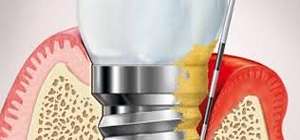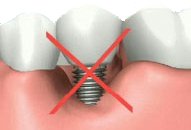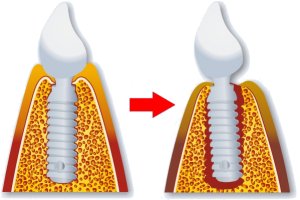Dental Implant Failure • Why, When and How to Fix

Dental Implant Failure
Dental implants placement is a complicated surgical procedure therefore failures can happen. Several factors such as surgical errors, infections, smoking, pre-existing dental or general health conditions can affect the success of treatment and lead to dental implant failure in about 5% of cases.
In this Article:
What is the Success / Failure Rate of Dental Implants
Available studies indicate that surgical placement of standard root-form implants has a success rate of 90-95% in general. Recent advances in dental technology and materials have allowed experienced implant dentists to claim success rates over 98%.
Most of the dental implant complications occur during the first year after the surgical placement and usually before the placement of the abutment and the restoration.
Success rates of dental implants are usually measured over a 5 year period after placement. After the first year, failure rate is around 1% per year and in most cases due to implant infection caused by improper aftercare and poor oral hygiene. With proper care, implants can last for a lifetime without any problems or need of maintenance (such as needed for bridges or dentures).
Dental Implant failure rate by area of mouth

Different areas of the mouth have different dental implant failure rates due to their special characteristics. The placement of implant in the front parts of the lower jaw has to demonstrate the best success rate as high as 98-100%. Failure rate in any position of the lower jaw is smaller than that of the relative position of the upper jaw because the bone quantity and density is usually better in the lower jaw.
The areas that have the higher implant failure rates 5-15% are these of the posterior (back) molar teeth, especially these of the upper jaw. Replacing back teeth with implants requires a much more difficult procedure that could challenge the dentist's training and experience. Additionally back teeth have to withstand more pressure during chewing which could negatively affect the proper bonding of implants to the jawbone. For the front part of the upper jaw the failure rate of iplants is between 5-10%.
Dental implant success rate is mostly related to dentist's skill, quality and quantity of the jaw bone available at the surgical site, and also to the patient's oral hygiene.
What are the Signs of a Failed Implant?
 Dental implants may fail for a number of reasons but it is more often related to a failure in the osseointegration process
(failure to bond properly with the jawbone).
Failure is determined by the inability to achieve and maintain implant stability, or by structural damage of the post or abutment.
Dental implants may fail for a number of reasons but it is more often related to a failure in the osseointegration process
(failure to bond properly with the jawbone).
Failure is determined by the inability to achieve and maintain implant stability, or by structural damage of the post or abutment.
Inflammation in the bone surrounding the implant is a first indication of possible problems. Spinning or moving around its vertical axis is a clear sign of implant failure. It is not unusual for a failed implant to simply fall out of its socket during chewing or talking. Technically a dental implant is considered to be a failure if it is lost, mobile or there is bone loss around it greater than 1.0 mm in the first year and greater than 0.2mm a year thereafter.
Groups with Increased Risk of Dental Implant Failures
Dental implant failures are statistically higher in some specific groups of patients. These include:
- Younger patients with jawbones not fully developed
- Patients with severe jawbone loss or low bone density
- Heavy smokers, drug or alcohol abusers
- Patients with chronic diseases like diabetes, hemophilia, or immune system deficiencies
- Patients who have had radiation therapy to the head/neck area
- People with bruxism problems
What to Do / Options After a Dental Implant Failure
In case of a dental implant failure the dentist has to remove it, treat the cause of the failure and replace it with a new one. The process may differ depending on the type of problem:
- implant breakage without jawbone damage - in this case the dentist can place the new implant immediately after removing the damaged one.
- implant infection or osseointegration problems
- medium bone loss - the dentist will leave the bone to heal, after eliminating the cause of the failure. The new implant can be placed a few months later.
- severe bone loss - if an infection or other reason has caused severe bone loss, the dentist will have to perform a bone grafting procedure, before attempting to replace the failed implant with a new one. If the implant is used to support a denture, the dentist may place a new implant in a slightly different but more suitable position to avoid bone grafting.
next page -> What are the Common Dental Implant Complications?



